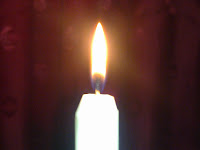The following article includes pertinent information that may cause you to reconsider what you thought you understood. The most important thing is to study with an open mind and be willing to revise your understanding if necessary. If you don't have accurate details regarding science, then you might make a bad choice on the subject. Don't let that happen: keep reading.
We all must have been familiar with candles. Yes, a thing that can give light in darkness. But have we ever wondered how a candle can light a fire? In this article I will try to describe it in a concise and hopefully easy to understand.
Candles made of flammable substance called paraffin. In a paraffin wax contains the element Carbon (C). When paraffin exposed to fire, the molecules in the paraffin will turn into another molecules form contains of carbon. This molecules is floating around the fire and the candles, and the candle combines it with Oxygen (O2) from the air into Carbon Dioxide (CO2) and produce an energy. The energy is light and heat. When we look at the size of a burned candle, the candle will slowly shrinking. It is not because the fire consumes the candle, but because the paraffin wax has been changed into energy molecules that produce fire and heat. The life of fire relies heavily on the paraffin wax, so when the paraffin has gone there will be no other energy that can provide fire and heat. This is what we call a chemical change
The changing process of paraffin molecules into a fire can not be seen with our eye. But try to look at when we blow out a burning candle, when the candle is out, there will be milky white smoke coming out and also the smell of paraffin. This is because paraffin has been changed back from the energy molecules into smoke before it disappears along with the air. This white smoke is the rest of paraffin that has not turned yet into a flame because there is no source to generate fire and heat anymore.
Paraffin can not be lit by themselves. Like the fire that needs a paraffin wax, but paraffin also needs a fire source to be able to create a flame. Now we will prove through a small experiment that the smoke comes out from a candle when it's blown out is the paraffin molecules that turns into smoke. My friends thought that I used some magic trick when I did this : ). There is no magic in this thing, it is completely science.
Things to prepare:
1..Set up a candle and a match.
2.Light the candle with a match until the flame of the candle burns perfectly.3.Then blow the candle until the flame dies and the white smoke comes out from the candles.
4.Light your match and direct the fire into the smoke but not too far from the wick.
 | |||||||||||||||||||||||||||||||||||||||||||||||||||||||||||||||||||||||||||||||||||||||||||||||||
5.Don't be too long because the fumes of paraffin will soon be gone with the air and the smoke is left only a residue of burning wick, so it won't work. Try it and Abracadabra ... see for your self that the candles can be lit without you touching the wick.




